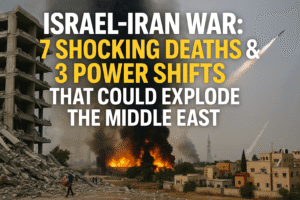Israel-Iran War: 7 Shocking Deaths & 3 Power Shifts That Could Explode the Middle East
Escalating Israel-Iran strikes have killed civilians, targeted critical infrastructure, and derailed diplomacy. Missiles tore through a Bat Yam apartment building near Tel Aviv, burying families and killing six (including children), while Iranian energy facilities in Tehran burned. Israel’s shift to attacking oil refineries threatens global fuel prices and inflation. Iran’s retaliation deliberately struck civilian zones, signaling dangerous normalization of urban warfare. Diplomatic channels collapsed as the UN postponed Israel-Palestine talks and Iran canceled nuclear negotiations.
Though regional proxies like the Houthis launched missiles, their weakened state limits Iran’s reach. Trump’s contradictory stance—hosting militaristic parades while offering mediation—underscores global leadership failures. With no ceasefire in sight, civilians remain trapped in a cycle of retaliation that shatters both homes and geopolitical stability.

Israel-Iran War: 7 Shocking Deaths & 3 Power Shifts That Could Explode the Middle East
As Israeli and Iranian missiles crossed paths overnight, civilians bore the brunt:
- Bat Yam’s Apocalypse: A residential tower near Tel Aviv collapsed, burying families. Seven missing, six dead—including children—and 180 wounded. Survivors fled with suitcases through glass-strewn streets as drones searched for bodies.
- Iran’s Burning Heart: Tehran’s Shahr Rey oil refinery and Shahran fuel depot blazed after Israeli strikes. While Iran claims 78 dead, global eyes fixate on crippled energy infrastructure.
- Northern Fronts: Four killed in Tamra; Rehovot’s Weizmann Institute—a science beacon—miraculously spared casualties despite direct hits.
Why This Escalation Changes Everything
- Civilian Targets as Policy: Iran’s defiance of Israeli warnings against striking non-military sites signals a dangerous normalization of urban warfare.
- Oil as a Weapon: With attacks on Iranian refineries, global markets shuddered. AMP economists warn of 12¢/L fuel hikes in Australia—linking Middle Eastern flames to worldwide inflation.
- Proxy War Unraveling: Houthi missiles targeting Israel (claiming coordination with Iran) reveal a fragmented network. Hezbollah and Hamas remain weakened, reducing Iran’s strategic buffer.
The Silent Crisis: Diplomacy in Retreat
- UN Paralysis: The postponed two-state solution talks underscore how regional conflict sabotages Palestinian-Israeli dialogue.
- America’s Dilemma: Trump’s social media gambit—“We can easily get a deal done”—contrasts with his military parade spectacle. Yet U.S. boots stay grounded, offering only defensive aid.
- Saudi Arabia’s Whispered Diplomacy: Crown Prince Salman’s emergency call to Iran’s President Pezeshkian signals Gulf states’ panic over spillover risks.
Expert Lens: The Long Game
Retired Major General Mick Ryan (Lowy Institute) notes:
“Israel’s expanded target list—from nuclear sites to oil—shows punitive escalation. But without U.S. ground involvement, this becomes a war of endurance. Iran’s new maneuvering warheads could penetrate defenses next time.”
Human Faces in the Rubble
- Bat Yam’s Unspoken Grief: Daniel Hadad, the local police commander coordinating rubble searches, embodies a nation’s trauma: “35 missing. We dig for neighbors.”
- Tehran’s Economic Anguish: Oil analyst Saul Kavonic warns: “Today’s domestic strikes could become tomorrow’s global supply crisis. $73/barrel is just the start.”
What Comes Next?
- Immediate Threat: Sirens blared across northern Israel Sunday afternoon—new infiltrations suspected.
- Global Ripples: Protests against Trump’s “king-like” militarism (“No Kings” rallies drew millions) clash with fears of expanded war.
- The Only Path: As Turkish President Erdogan told Iran’s leader: “Diplomacy is the solitary solution.” Yet with nuclear talks canceled, the missiles still fly.
The true cost? Not in barrels or headlines, but in children pulled from ruins and scientists fleeing research centers. Until leaders prioritize ceasefires over vengeance, the cycle accelerates—with ordinary people paying the price.
You must be logged in to post a comment.